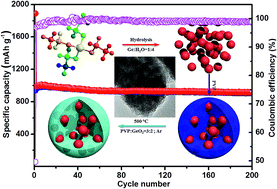Uniform GeO2 dispersed in nitrogen-doped porous carbon core–shell architecture: an anode material for lithium ion batteries†
Abstract
Germanium oxide (GeO2), which possesses great potential as a high-capacity anode material for lithium ion batteries, has suffered from its poor capacity retention and rate capability due to significant volume changes during lithiation and delithiation. In this study, we introduce a simple synthetic route for producing nanosized GeO2 anchored on a nitrogen-doped carbon matrix (GeO2/N–C) via the sol–gel method followed by a calcination process in an inert argon atmosphere. The GeO2/N–C showed superior electrochemical performance over pure GeO2; almost 91.8% capacity retention of 905 mA h g−1 was shown after 200 cycles at the rate of C/2. Interestingly, even at a high rate of 20C, a specific capacity of 412 mA h g−1 was retained. This unique anode performance of GeO2/N–C is derived from the effective combination of nano-size GeO2 and its uniform distribution in a nitrogen-doped carbon matrix. Herein, the nitrogen doped-carbon matrix not only strengthens the structure but also promotes the lithium diffusion in the GeO2/C–N material. Further, the adaptability of GeO2/N–C as an anode in a full cell configuration in combination with the LiCoO2 cathode was demonstrated by exhibiting high specific capacity and good cyclability.


 Please wait while we load your content...
Please wait while we load your content...